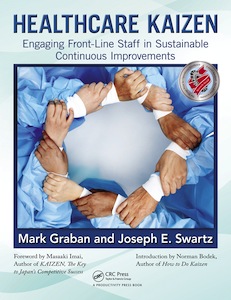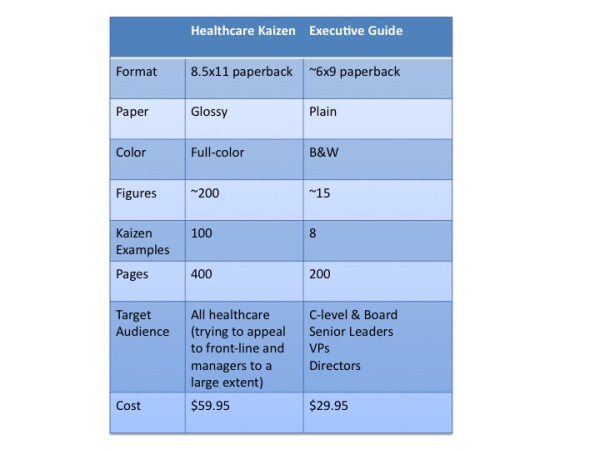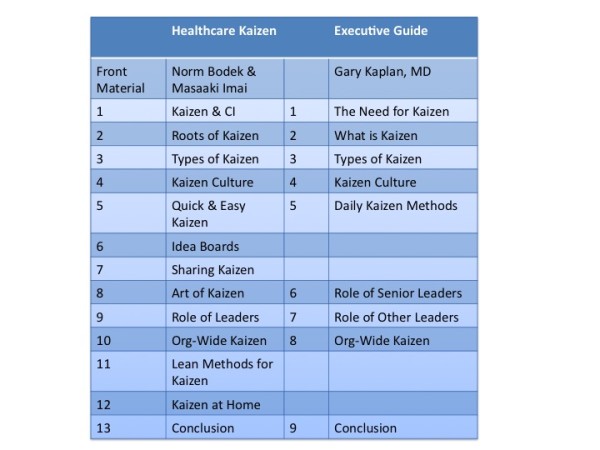Contents

Table of Contents – Healthcare Kaizen
Full book description | Download TOC as PDF
Part I: What is Kaizen?
1) Intro to Kaizen
- This chapter introduces the reader to Kaizen as a continuous improvement model and how Kaizen follows the Plan-Do-Study-Adjust (PDSA) cycle and the scientific method. Kaizen starts with small changes, focused on engaging everyone in their own improving their own work in a way that matters for patients and staff.
2) Kaizen History
- This chapter discusses the roots and evolution of employee suggestion systems into present day healthcare. A large emphasis is placed in the differences between traditional “suggestion box” models and the practices of Kaizen.
3) Types of Kaizen
- This chapter discusses the “three levels of kaizen” as adapted from Toyota, ranging from large strategic changes to weeklong events to daily kaizen. This chapter also attempts to explain the differences between Kaizen and so-called Kaizen events and how these approaches are built on PDSA and how they are complementary, not competing.
4) Kaizen Culture
- Drawing heavily on the experiences of Franciscan St. Francis, what does a “kaizen culture” feel like for staff, leaders, and patients? What are some of the mindsets required to start kaizen and make it successful?
Part II: Kaizen Methods
5) Quick and Easy Kaizen
- Provides a description of the method used for encouraging, documenting, and sharing kaizen improvements at Franciscan St. Francis, with many examples (including some from other organizations). The basic model of “QnEK” is to find, discuss, implement, document, and share improvement ideas, focused on small changes that can be done quickly and easily.
6) Visual Idea Boards
- Description of the method used for tracking and implementing improvement ideas, as originally written about in David Mann’s Creating a Lean Culture and in Mark Graban’s Lean Hospitals. Many examples are shared to illustrate method and the ways managers can coach employees in kaizen.
7) Sharing Kaizen
- Illustration of different methods for documenting and sharing Kaizen improvements, including the “Kaizen Wall of Fame,” A3 reports, and other variations of simple summaries of Kaizens. Sharing improvements gives recognition to staff members, helps spread good ideas, and inspires more improvement.
Part III: Kaizen Lessons Learned
8) The Art of Kaizen
- A discussion of shifting from what might be seen as organizational “barriers to Kaizen” to models for engaging different types of staff members in continuous improvement.
9) The Role of Leaders in Kaizen
- What should be the specific role and actions of leaders at different levels: top-level, middle, and front-line managers? How can leaders participate in Kaizen – promoting, supporting, coaching, and sharing improvements.
10) Creating an Organization-Wide Kaizen Program
- This chapter covers how to create an organization-wide program with examples from Franciscan St. Francis and several other hospitals. Additional lessons and pointers are shared, including the pros and cons of different reward systems for Kaizen, as well as methods for the electronic documentation and sharing of Kaizens.
11) Lean Methods for Kaizen
- Discusses the incorporation of broader “Lean” improvement methods into the practice of Kaizen, based on Franciscan’s staff education and experience.
12) Kaizen at Home
- A chapter on the application and adoption of a “Kaizen lifestyle” with examples generated at home and outside the workplace by Franciscan staff members and other healthcare professionals .
Conclusion
- A brief summary of Kaizen principles and call to action for readers and their organizations.
Book Summary | Google Books Preview
A comparison of Healthcare Kaizen and The Executive Guide and their chapters:


